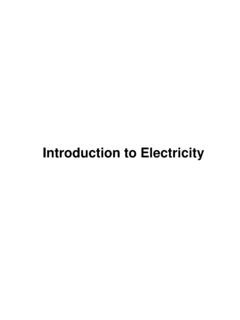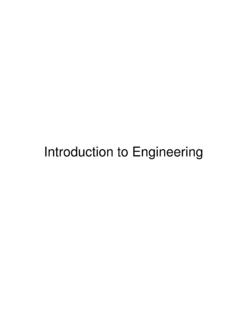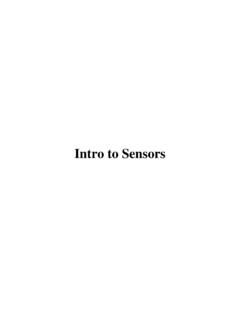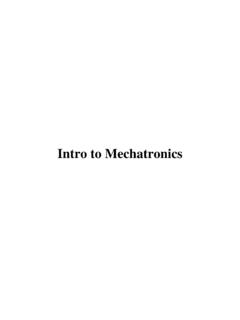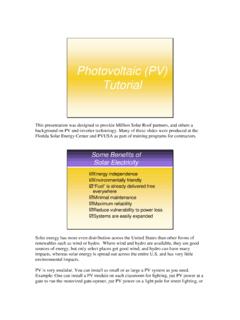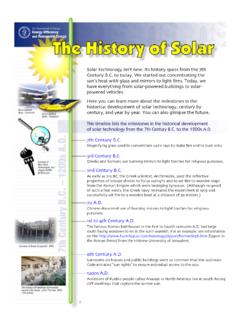Transcription of Basic Electronics - engineering.nyu.edu
1 Basic ElectronicsSemiconductor I Materials that permit flow of electrons are called conductors ( , gold, silver, copper, etc.). Materials that block flow of electrons are called insulators ( , rubber, glass, Teflon, mica, etc.). Materials whose conductivity falls between those of conductors and insulators are called semiconductors. Semiconductors are part-time conductors whose conductivity can be II Silicon is the most common material used to build semiconductor devices. Si is the main ingredient of sand and it is estimated that a cubic mile of seawater contains 15,000 tons of Si. Si is spun and grown into a crystalline structure and cut into wafers to make electronic III Atoms in a pure silicon wafer contains four electrons in outer orbit (called valence electrons).
2 Germanium is another semiconductor material with four valence electrons. In the crystalline lattice structure of Si, the valence electrons of every Si atom are locked up in covalent bonds with the valence electrons of four neighboring Si atoms. In pure form, Si wafer does not contain any free charge carriers. An applied voltage across pure Si wafer does not yield electron flow through the wafer. A pure Si wafer is said to act as an insulator. In order to make useful semiconductor devices, materials such asphosphorus (P) and boron (B) are added to Si to change Si valence electronsN-Type Silicon Pentavalentimpurities such as phosphorus, arsenic, antimony, and bismuth have 5 valence electrons. When phosphorus impurity is added to Si, every phosphorus atom s four valence electrons are locked up in covalent bond with valence electrons of four neighboring Si atoms.
3 However, the 5thvalence electron of phosphorus atom does not find a binding electron and thus remains free to float. When a voltage is applied across the silicon-phosphorus mixture, free electrons migrate toward the positive voltage end. When phosphorus is added to Si to yield the above effect, we saythat Si is doped with phosphorus. The resulting mixture is called N-type silicon (N: negative charge carrier silicon). The pentavalentimpurities are referred to as donor valence electronsP-Type Silicon I Trivalent impurities , boron, aluminum, indium, and gallium have 3 valence electrons. When boron is added to Si, every boron atom s three valence electrons are locked up in covalent bond with valence electrons of three neighboring Si atoms. However, a vacant spot hole is created within the covalent bond between one boron atom and a neighboring Si atom.
4 The holes are considered to be positive charge carriers. When a voltage is applied across the silicon-boron mixture, a hole moves toward the negative voltage end while a neighboring electron fills in its place. When boron is added to Si to yield the above effect, we say thatSi is doped with boron. The resulting mixture is called P-type silicon (P: positive charge carrier silicon). The trivalent impurities are referred to as acceptor valence electronsP-Type Silicon II The hole of boron atom points towards the negative terminal. The electron of neighboring silicon atom points toward positive terminal. The electron from neighboring silicon atom falls into the boron atom filling the hole in boron atom and creating a new hole in the silicon atom.
5 It appears as though a hole moves toward the negative terminal!Diode A diode is a 2 lead semiconductor that acts as a one way gate toelectron flow. Diode allows current to pass in only one direction. A pn-junction diode is formed by joining together n-type and p-type silicon. In practice, as the n-type Si crystal is being grown, the process is abruptly altered to grow p-type Si crystal. Finally, a glass or plastic coating is placed around the joined crystal. The p-side is called anode and the n-side is called cathode. When the anode and cathode of a pn-junction diode are connected to external voltage such that the potential at anode is higher than the potential atcathode, the diode is said to be forward biased. In a forward-biased diode current is allowed to flow through the device.
6 When potential at anode is smaller than the potential at cathode, the diode is said to be reverse biased. In a reverse-biased diode current is blocked.+-+-Water Analogy of Diodes When water pressure on left overcomes the restoring force of spring, the gate is opened and water is allowed to flow . When water pressure is from right to left, the gate is pressed against the solid stop and no water is allowed to flow. Spring restoring force is analogous to needed to forward bias a Si : How it Works I When a diode is connected to a battery as shown, electrons from the n-side and holes from the p-side are forced toward the center by the electrical field supplied by the battery. The electrons and holes combine causing the current to pass through the diode.
7 When a diode is arranged in this way, it is said to be ( open door )Repels holesRepels electronsDiode: How it Works II A diode s one-way gate feature does not work all the time. Typically for silicon diodes, an applied voltage of or greater is needed, otherwise, the diode will not conduct. This feature is useful in forming a voltage-sensitive switch. I-V characteristics for silicon and germanium diodes is shown : How it doesn t work When a diode is connected to a battery as shown, holes in the n-side are forced to the left while electrons in the p-side are forced to the right. This results in an empty zone around the pn-junction that is free of charge carries creating a depletion region. This depletion region acts as an insulator preventing current from flowing through the diode.
8 When a diode is arranged in this way, it is said to be ( closed door )Attracts holesAttracts electronsDiode Applications Half Wave Rectifier Diode converts ac input voltage to a pulsed dc output voltage. Whenever the ac input becomes negative at diode s anode, the diode blocks current flow. o/p voltage become zero. Diode introduces a drop so o/p peak is smaller than the i/p peak. The o/p frequency is same as the i/p Applications Full Wave Rectifier A full-wave rectifier does not block negative swings in the i/p voltage, rather it transforms them into positive swings at the o/p. To gain an understanding of device operation, follow current flow through pairs of diodes in the bridge circuit. It is easily seen that one pair (D3-Rout-D2) allows current flow during the +vehalf cycle of Vinwhile the other pair (D4-Rout-D1) allows current flow during the -vehalf cycle of Vin.
9 O/p voltage peak is below the i/p voltage peak. The o/p frequency is twice the i/p Applications AC2DC Power Supply An AC2DC power supply is built using a transformer and a full-wave rectifier. Transformer is used to step down the voltage i/p. Rectifier converts AC to pulsed DC. A filter capacitor is used to smooth out the pulses. Capacitor must be large enough to store sufficient charge so as to provide a steady current supply to the load:fis rectified signal s frequency (120Hz).1/LoadRCf Transistor A three lead semiconductor device that acts as: an electrically controlled switch, or a current amplifier. Transistor is analogous to a faucet. Turning faucet s control knob alters the flow rate of water coming out from thefaucet. A small voltage/current applied at transistor s control lead controls a larger current flow through its other two inWater outTransistor Types: BJT, JFET, and MOSFET Bipolar Junction Transistor (BJT) NPN and PNP Junction Field Effect Transistor (JFET) N-channel and P-channel Metal Oxide Semiconductor FET (MOSFET) Depletion type (n-and p-channel) and enhancement type (n-and p-channel)BJTMOSFETJFETBJT Types NPN and PNP.
10 NPN: a small input current and a positive voltage applied @ its base (with VB>VE) allows a large current to flow from collector to emitter. PNP: a small output current and a negative voltage @ its base (with VB<VE) allows a much larger current to flow from emitter to BJT: How it works I When no voltage is applied at transistor s base, electrons in the emitter are prevented from passing to the collector side because of the pnjunction. If a negative voltage is applied to the base, things get even worse as the pnjunction between the base and emitter becomes reverse-biased resulting in the formation of a depletion region that prevents current BJT: How it works II If a positive voltage (> ) is applied to the base of an npntransistor, the pnjunction between the base and emitter becomes forward-biased.
